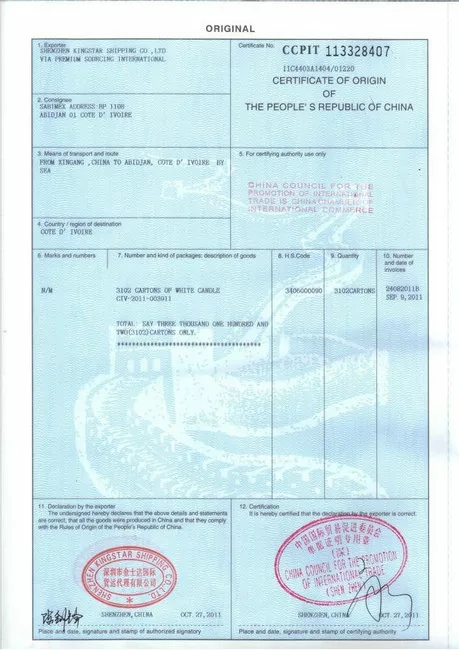
The China Certificate of Origin is a crucial document in international trade, as it certifies that the exported products are wholly obtained, produced, or manufactured within the borders of China. While it may appear as a simple piece of paper, the Certificate of Origin carries significant weight in the world of international trade, as it serves to verify a product’s true origins and compliance with applicable trade rules and regulations. This certification serves as an assurance for consumers and trading partners regarding the true origins of the commodities they are purchasing. As a result, it is essential for importers and exporters to understand the importance and requirements of obtaining and verifying a China Certificate of Origin.
Understanding Certificate of Origin
Role of Certificate of Origin in International Trade Transactions
A Certificate of Origin (CO) is necessary for several reasons:
- It helps determine customs duties, tariffs, and other trade regulations that might apply to imported goods.
- CO ensures that the products meet the importing country’s standards and requirements.
- It serves as proof of the product’s eligibility for preferential treatment under specific trade agreements, if applicable.
Preferential and Non-Preferential Certificate of Origin
There are two types of Certificates of Origin: preferential and non-preferential.
- Preferential certificate of origin: This type indicates that the exported goods are subject to reduced or eliminated customs duties under particular trade agreements, such as Free Trade Agreements (FTAs) or Generalized System of Preferences (GSP). Importers can benefit from preferential tariffs, offering a competitive advantage in the market.
- Non-preferential certificate of origin: This type certifies the origin of goods without being associated with any preferential trade agreements. It is required for customs clearance and compliance with trade regulations but does not provide tariff benefits.
Roles in Certificates of Origin
Certificates of Origin play a crucial role in international trade, as they help to establish the origin of goods. In this section, we will explore the roles of exporters and importers in the process of obtaining and using Certificates of Origin.
Role of Exporters
Exporters, typically businesses that manufacture or produce goods for export, have a significant responsibility in the process of obtaining a Certificate of Origin. It is their duty to ensure that the exported goods meet the necessary criteria to be considered as originating from their respective country. Some key aspects that exporters need to consider are:
- Accurately declaring the origin of the goods on the Certificate of Origin.
- Providing any relevant documentation, such as a commercial invoice, to support the declaration made on the Certificate of Origin.
- Ensuring the goods are compliant with the importing country’s customs requirements and trade regulations.
By fulfilling these responsibilities, exporters can facilitate smoother customs clearance for their exported goods, making the process more efficient for both themselves and the importers who receive their products.
Role of Importers
Importers, on the other hand, are responsible for verifying and ensuring that the goods they receive have the correct Certificate of Origin. This can be a critical step in the process of importing, as it impacts customs clearance and possibly the tariff treatment of the goods. Some responsibilities and aspects importers should be aware of include:
- Checking the Certificate of Origin received from the exporter, ensuring it accurately represents the origin of goods.
- Ensuring the Certificate of Origin meets the requirements of the importing country’s customs authorities, and adhering to trade regulations.
- Keeping accurate records of the goods received, including their origin, to facilitate the customs clearance process.
Documents Needed Alongside Certificate of Origin
When submitting a Certificate of Origin, certain supporting documents are necessary. These include:
- Declaration of Origin: A statement by the exporter stating the origin of goods.
- Certificate number: A unique identifier for the CO, given by the issuing authority.
- HS code: The Harmonized System (HS) code, a standardized numerical code to classify traded products.
- Commercial invoice: A document detailing the transaction between the exporter and importer, including product description, quantity, price, and terms of payment.
- Place-of-origin investigation results: Required only for goods manufactured at a foreign location, issued by the authorities responsible for CO.
China Certificate of Origin Samples

When importing goods from China, you may encounter several types of C/Os, including Form A, Form B, Form E, Form F, Form L, Form N, Form P, and Form R. Each form is specific to certain countries or regions, and it’s essential to acquire the appropriate certification for your goods.
Form A is a “Generalized System of Preferences Certificate of Origin” applicable to countries such as Britain, France, Germany, Italy, Japan, Australia, Canada, and Turkey, among others. Form B, the “Certificate of Origin according to the Asia-Pacific Trade Agreement,” is valid for countries like Bangladesh, India, South Korea, Laos, and Sri Lanka. Form E is applicable to members of the ASEAN-China Free Trade Area and countries like Brunei, Cambodia, Indonesia, Malaysia, and the Philippines.
For trading partners under specific free trade agreements (FTAs), specific forms apply: Form F for China-Chile FTA, Form L for China-Costa Rica FTA, Form N for China-New Zealand FTA, Form P for China-Pakistan FTA, and Form R for China-Peru FTA.
To obtain a Certificate of Origin, your supplier (be it a trading company or manufacturer with an export license) needs to provide information such as exporting party, consignee, means of transport and route, country/region of destination, marks and numbers, number and kind of packages, H.S. Code, quantity, and number and date of invoices. In China, the certification can be issued by the local AQSIQ authority (General Administration of Quality Supervision, Inspection and Quarantine of P.R.C.) or CCPIT (China Council for the Promotion of International Trade).
It is crucial to apply for the C/O before the shipment’s Estimated Time of Departure (ETD) to ensure the certification is issued on time without the “ISSUED RETROSPECTIVELY” remark. The original C/O will usually be issued in 1-2 working days, and there is no electronic version available. Remember that all shipping documents from China should be consistent, so the details on the Bill of Lading, Packing List, Commercial Invoice, and Certificate of Origin must align.
How to Fill in the Certificate of Origin
Before filling in the certificate of origin, the applicant must register with their local visa agency using their business license and other relevant documents. Once registered, the applicant should undergo training with an inspection and quarantine agency and obtain the applicant certificate.
When completing the certificate of origin, consider the following steps:
- Prepare the necessary documents: Collect all the required documents, including the general certificate of origin application, commercial invoice, and a detailed product cost statement if the product contains imported ingredients.
- Apply for a visa: At least three days before shipping the goods, apply for a visa with the inspection and quarantine agency and submit all the collected documents.
- Complete the certificate of origin: Fill in the certificate with accurate and clear information. Sign and stamp the certificate with the official seal of the applicant. Make sure to produce quadruplicate copies of the certificate.
In special circumstances, such as when the certificate cannot be applied for in time, a post-issued certificate may be requested. To modify the contents of an issued certificate, complete a modified application form, stating the reason for the change, and provide the necessary basis for the change. Return the originally issued certificate to the issuing agency for further verification.
Handling certificates of origin for shipping goods from China can be complex, but understanding the process and completing the certificate correctly will ensure smooth customs clearance and adherence to trade regulations. Remember to consult the appropriate agency, such as the Council for the Promotion of International Trade, for assistance in obtaining and completing the certificate of origin.
Application and Issuance Process

The application and issuance process for a Certificate of Origin in China is streamlined and efficient, focusing on enhancing trade efficiency. To begin with, applicants can submit electronic applications for a Certificate of Origin. This saves time and resources while allowing for faster processing.
Electronic issuance of a Certificate of Origin is becoming more common as well, making it easier for exporters to acquire the necessary documentation quickly. This modern method provides a secure and efficient way to receive the certificate as it can be transmitted electronically and printed locally.
Upon application, the exporter may be required to submit a letter of undertaking to ensure compliance with the regulations and facilitate the electronic issuance of the Certificate of Origin. This critical document serves as a guarantee from the applicant, stating that they will abide by the relevant rules and requirements.
Before the application, exporters should undergo a product record-filing procedure, which entails submitting relevant product information and technical specifications. This step is crucial as it helps authorities verify the origin and nature of the goods and ensure they meet the necessary standards.
Lastly, the product origin inspection process plays a key role in obtaining the Certificate of Origin. It involves assessing the goods, examining their quality, and confirming their origin to ensure that they are eligible for export under the regulations. This inspection is vital in maintaining international trade standards and protecting consumers from substandard products.
Frequently Asked Questions
How do I verify a Certificate of Origin from China?
Verification of a Certificate of Origin from China can be carried out through the e-government platform for China’s export origins. In case of any issues during verification, you can email the platform support team with details like the country or region, error message, and certificate number.
What is the Form E Certificate of Origin?
The Form E Certificate of Origin is a preferential certificate issued by China for exports to countries with which it has free trade agreements (FTAs). This certificate helps businesses benefit from lower or eliminated tariffs on their exports. It is essential to comply with the rules of origin to be eligible for Form E.
Is there an e-government platform for China’s export origins?
Yes, there is an e-government platform available for the origin of China’s exports. The platform provides access to electronic certificates and a reliable means to verify and validate the authenticity of the documents electronically.
What is the country of origin code for China?
The country of origin code for China is “CN.” This code is used in international trade and shipping documentation to represent the People’s Republic of China.
